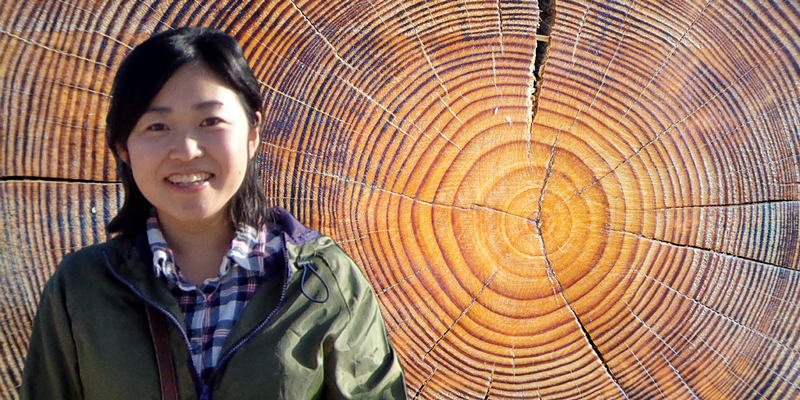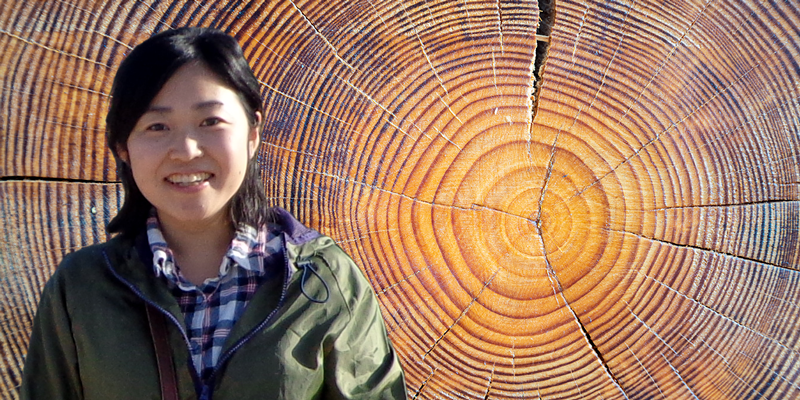Sun’s Past Hidden in Tree Rings
As our closest star, the Sun presents a unique opportunity for understanding the dynamic nature of a hot ball of stellar plasma. But it’s only in the last few decades that researchers have been able to directly measure the Sun’s activity, such as the fluctuation of its magnetic fields and its sudden bursts of high-energy particles. Fusa Miyake of Nagoya University in Japan wants to extend that knowledge further into the past to understand the Sun’s behavior over longer timescales. To do that, she measures the abundances of isotopes in tree rings that formed up to thousands of years ago.
The technique has allowed her to discover spikes in isotope abundances that occured hundreds or thousands of years ago. These spikes, which radiocarbon scientists call Miyake events, may result from ancient solar flares or other energetic events. In a conversation with Physics, Miyake explains why and how she mines trees for historical records of solar activity.
–Erika K. Carlson
How do you learn about the Sun by studying tree rings?
From the carbon inside the tree rings. Carbon-14 and some other isotopes, such as beryllium-10, are created in the atmosphere when cosmic rays from the Sun and from outside the Solar System reach Earth. That carbon-14 gets absorbed by trees and engraved into tree rings. By studying the amount of carbon-14 in a given ring, we can learn something about the Sun’s activity at the time that the ring formed.
How does the Sun’s activity impact how much carbon-14 gets made?
Cosmic rays are charged particles, so their paths can be diverted by magnetic fields, including that of the Sun. When solar magnetic activity is strong, the Sun’s magnetic field deflects many of the cosmic rays that would have arrived at Earth from outside the Solar System. So fewer cosmic rays reach Earth, and less carbon-14 gets made.
The Sun also emits cosmic rays. When there is an explosive event like a solar flare, the Sun spews out more cosmic rays and the amount of carbon-14 that gets made increases. So the Sun affects carbon-14 production in multiple ways, but you can look at the timescales of the effects to distinguish them. The Sun’s magnetic activity tends to vary on longer timescales, like the famous 11-year Schwabe cycle, while solar flares usually last only a few days. In the carbon-14 data, a flare will look like a sharp increase in one year’s carbon-14.
Why are you interested in studying the Sun’s past activity?
I’ve always been interested in space because there are so many unknowns. I became especially interested in the Sun because there are so many things we don’t understand about it, even though it’s the closest star to us.
I’m doing this work now because I’m interested in the Sun’s long-term activity and in the relationship between solar activity and the occurrence of solar bursts. This information, and also understanding the frequency of large solar eruptions, is important for preparing for future events. I also think it’s fascinating that there are records of solar activity in the trees all around us.
Where do you get your wood samples?
The trees I use are mostly Japanese cedar trees that can be one to two thousand years old. These trees grow on the island of Yakushima, which is a World Heritage Site. Because of the protections this status affords, people can’t cut trees down on Yakushima, so I use stumps of dead trees that my colleagues bought years ago for research.
But we can look further back in time, longer than 2000 years, with the help of a technique called dendrochronology. There are patterns in tree ring widths that reflect the climate as the tree grew, so that in years when temperatures were warm, for example, tree rings were wider. By matching patterns from tree samples that span different ages, we can string together many samples to trace the record back farther into the past.
I myself don’t do this work. Dendrochronologists send me dated samples to use for my measurements.
What discoveries have you made from your experiments?
In 2012, I uncovered a sharp increase in carbon-14 in the year 775 that indicated that more cosmic rays were hitting Earth than usual. This carbon-14 spike was potentially caused by a solar event that was tens of times the scale of those known from direct observations. Until that point, there had never been traces of such large solar flares or explosions found, so I think that was my biggest discovery.
Since then, my colleagues and I have found similar increases in carbon-14 in tree rings in 994, in about 660 BCE, and even in about 5480 BCE. These findings indicate that big solar explosions are repeated events. What I’m most interested in now is what frequency these large events occurred at, so I’m focused on continuing to make these measurements to find that frequency.
What is your favorite thing about doing this work?
Finding an event. When I find signs of a solar explosion, that makes me happy.
Erika K. Carlson is a Corresponding Editor for Physics based in Brooklyn, New York.
Know a physicist with a knack for explaining their research to others? Write to physics@aps.org. All interviews are edited for brevity and clarity.





